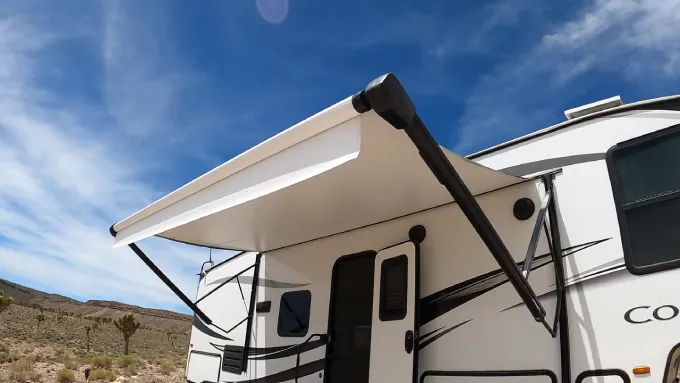Last Updated on April 13, 2023
RV awning provides a shaded area where you can sit and relax, entertain guests or simply enjoy the outdoors comfortably. But, have you ever wondered if your awning is vulnerable to sun damage?
RV awnings are exposed to the sun’s harmful UV rays, which can cause significant damage over time.
This article will explore the effects of sun exposure on RV awnings and provide tips on protecting them from damage. So grab a seat under your shady awning and dive into it.
Does Sun Damage RV Awnings: What You Need to Know?
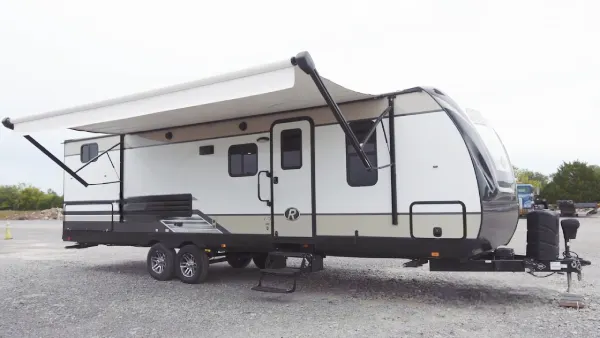
Prolonged exposure to the sun’s harmful UV rays can cause damage to the RV awning fabric, resulting in fading, discoloration, and even tears. Understanding sun damage’s signs, causes, and effects on RV awnings is essential.
Signs of Sun Damage
One of the most obvious warnings of sun damage on RV awnings is fading. The vibrant colors of the fabric can become dull and washed out over time due to exposure to UV rays. This can also lead to discoloration and uneven fading, making the awning look old and worn.
Another sign of sun damage is the cracking or peeling of the material. This occurs when the fabric becomes dry and brittle from prolonged exposure to sunlight. Over time, this can cause small tears or holes in the fabric, compromising its integrity and effectiveness as a shade option.
In addition to physical changes in the fabric, sun damage can also affect the functionality of RV awnings. For example, weakened materials may not withstand strong winds or heavy rain, leading to further damage or even complete failure of the awning.
Causes of Sun Damage on RV Awnings
One of the main causes of RV awnings’ sun damage is exposure to direct sunlight for extended periods. This exposure can cause the fabric to become brittle and weak, leading to tears and holes in the material. Also, high temperatures can accelerate this process by causing the fabric to dry out and lose its elasticity.
Another factor contributing to sun damage on RV awnings is the material used in making them. Some materials are more susceptible to UV damage than others. For example, vinyl awnings are more prone to fading and cracking than acrylic or polyester fabrics.
Furthermore, improper use and maintenance of RV awnings can also lead to sun damage. For instance, leaving the awning deployed during windy conditions can cause unnecessary stress on the fabric, leading to tears and other damage.
Effects of Sun Damage on RV Awnings
Over time, exposure to the sun’s UV rays can cause fading, cracking, and other forms of deterioration. The effects on RV awnings can be both aesthetic and functional.
One of the most apparent effects of sun damage is fading. The vibrant colors that once adorned the awning will slowly fade, making it look dull and lifeless. Fading occurs when the UV rays from the sun break down the pigments in the fabric, causing them to lose their color.
Another effect of sun damage is cracking or splitting of the fabric. This occurs when the material becomes brittle due to prolonged exposure to sunlight. The constant expansion and contraction caused by temperature changes can cause small cracks in the fabric, eventually leading to larger splits if left untreated.
Sun damage can also weaken the overall structure of an RV awning. Over time, prolonged exposure to sunlight weakens the fibers in the fabric, making it more susceptible to tears and other types of damage.
In addition to these functional issues, sun-damaged RV awnings can also detract from the appearance of your vehicle. A faded or cracked awning can make your RV look older and less well-maintained than it is.
Tips for Preventing Sun Damage on RV Awnings
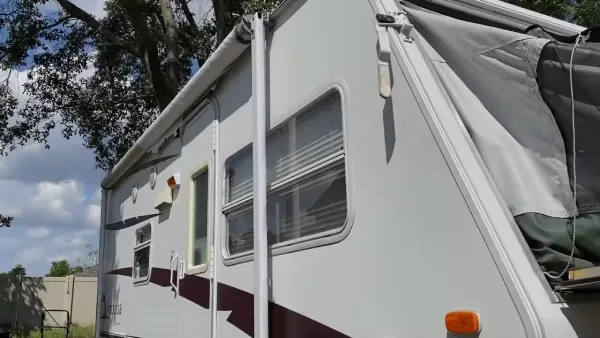
RV awnings can get damaged over time if exposed to the sun for too long. The good news is there are some tips for preventing RV awnings from sun damage.
UV Protection
UV Protection is essential in preventing sun damage on RV awnings. UV rays are a major cause of RV awning materials’ fading, discoloration, and deterioration. The longer the exposure to UV rays, the more damage it causes to the fabric, leading to cracks and tears.
To prevent sun damage on RV awnings, choosing awning materials with UV-resistant properties is crucial. This will help reduce the impact of harmful UV rays on your RV awning. Some popular options for UV-resistant materials include acrylic-coated polyester and vinyl-laminated polyester.
Another way to protect your RV awning from sun damage is by using a protective spray or coating that blocks out harmful UV rays. These products can be found at any camping supply store and are easy to apply.
Proper Use and Maintenance of RV Awnings
Proper use and maintenance are crucial to prevent sun damage to your RV awnings. To properly use your RV awning, make sure to extend it fully and secure it in place with the appropriate hardware.
Avoid leaving it partially extended, as this can cause stress on the fabric and lead to tears or holes. Also, always retract the awning during windy conditions or when you’re away from your RV to prevent damage.
Regular maintenance is also important for preventing sun damage on your RV awning. Clean your awning regularly with mild soap and water, avoiding harsh chemicals that can weaken the fabric.
Applying a protective coating or sealant specifically designed for RV awnings is also recommended to help repel water and reduce sun damage.
Inspecting your awning regularly is another key aspect of proper maintenance. Look for signs of wear, such as fraying or tears in the fabric, loose hardware, or bent arms. Address any issues promptly before they worsen and potentially cause more severe damage.
Alternative Shade Options for RVs
One popular alternative is a retractable canopy or pergola. These structures can be installed next to your RV, offering adjustable shade coverage throughout the day. Retractable canopies come in various materials and colors, allowing you to customize the look to match your RV’s aesthetic.
Another option is a portable canopy or gazebo. These lightweight structures are easy to set up and take down, making them perfect for camping trips or outdoor events. They come in various sizes and styles, so you can pick one that’s right for you.
If you prefer something more permanent, install a carport or metal awning next to your RV. These structures provide ample shade coverage and protect your RV from other elements like rain and snow.
How can I make my RV awning last longer from sun damage?
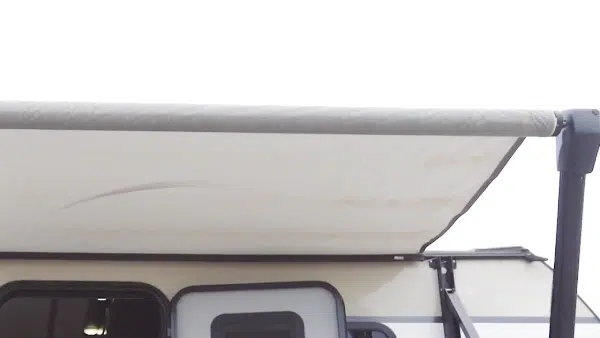
Sun rays can cause severe damage to the RV awning. To ensure that your RV awning lasts longer, it is essential to take some preventive measures.
The primary tip is to keep your awning rolled up when it’s not in use. This will protect it from direct sunlight, reducing the risk of cracking, fading, and other sun-related damage.
Also, you can use UV protectant sprays to shield your awning from the sun’s harmful rays. Regular cleaning and maintenance will also help prolong the life of your RV awning.
Can you repair an RV awning damaged by the sun?
Depending on the extent of the damage, there are some repairs that you can do to your RV awning. If your awning has suffered from discoloration or staining due to the sun’s UV rays, then a thorough cleaning with a specialized cleaner can restore its color.
Small cracks, holes, or tears in the awning can be repaired with a DIY patch kit, which can be easily found at any RV supply store. If the damage is more significant, it is advisable to consult a professional awning repair service to help you fix the issue.
How often should you replace an RV awning to avoid sun damage?
To avoid sun damage and ensure the longevity of your RV awning, it is recommended to replace it every 5-10 years. This will help you maintain the pristine condition of your RV awning and prevent any further damage caused by the sun’s UV rays.
But the time frame can vary depending on factors such as the amount of sunlight exposure, the fabric quality used, and maintenance practices. Regular cleaning, storing in a proper location, and using the awning can also extend its lifespan.
What RV awning materials resist sun damage?
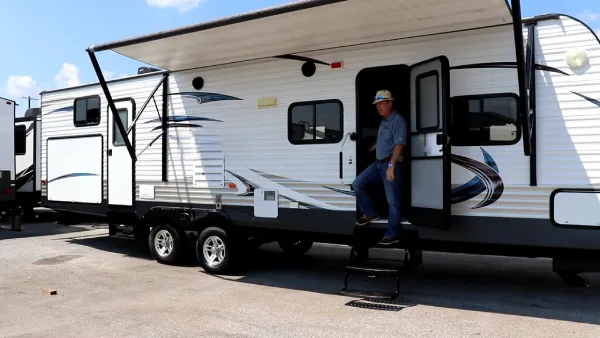
Acrylic Fabric is one of the best RV awning materials to resist sun damage. This fabric is specifically designed for long-term outdoor use. It is known for its durability and resistance to fading and deterioration caused by prolonged exposure to the sun’s UV rays.
It retains its color for longer and is resistant to mildew, stains, and moisture. Compared to other materials like vinyl or polyester, acrylic fabric has a softer feel and better breathability, contributing to its ability to resist sun damage.
Choosing an RV awning material for long-term outdoor use is always advisable and offers excellent UV resistance for a longer lifespan.
Protect Your Investment: Know the Signs of Sun Damage on RV Awnings
Sun damage is a severe issue that can affect the lifespan and functionality of your RV awning. Knowing the signs of sun damage on your RV awning is crucial in preventing further harm.
Some common indicators include fading, cracking, and peeling. These damages can lead to more severe effects like leakage and reduced protection from harmful UV rays.
Proper maintenance and care are recommended to minimize sun damage on your RV awning. Regular cleaning and inspection can help detect early signs of wear and tear. Also, alternative shade options for your RV such as add-on screens or portable canopies, can provide additional protection from the sun’s harmful rays.
